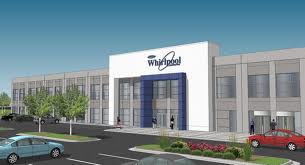Origin of The Report:
In this chapter we tried to describe the origin of the report, objective of the report, scope and limitations of the report.
Objective of The Report:
The BBA Program under the department of finance offers a course named “Management (F-108)” which requires submitting a report on a specific topic determined by the course instructor. The report under the headline ‘Whirlpool Corporation’ has been prepared towards the purpose.
Objective of the report:
There are several objectives to conduct the study which are:
To Provide an overall information about the whirlpool company
To provide the position in the BCG Matrix
To analyze the SWOT of the organization
To give an economical analysis.
Methodology:
To prepare this report we mainly depend on the primary data. But also take some help from our seniors.
Process of collecting secondary data:
We went to our senior to know about the procedure of making a good report. Then we ask for advices that should be followed to collect a standard data.
Process of collecting primary data:
Primary data are collected from the following sources:
We collected our necessary primary data by the help of internet. Here the web address of Whirlpool proved to be very helpful to us.
Reasons for collecting primary data:
It is not possible to complete the report with the secondary data.
To cross checking the secondary data couldn’t be possible without using primary data.
Scope of The Report:
Everything has some advantage which helps that work to be completed thoroughly. We get some scope which helps us to make a standard report. Major of them are-
Enough Time: We have got enough time to prepare a report so that we could gather information with much tension free mind. .
Easy access to internet: We have a very smooth access to internet in our computer lab. So that we didn’t face any kind of trouble in this sector.
Limitation of The Report:
Easy Topic: The topic of us was much easier than others. So we don’t feel any problem about our topic.
Limitation of the report:
Every study has some limitations. We faced some usual constraints during the course of our preparation for the report. The major limitations are as follows:
Lack of knowledge: We don’t have enough knowledge about how to prepare a report. So face some problems by this side.
Whirlpool Corporation
Couse Name : Managemet (F-108)
Company Profile:
Establishment:
Whirlpool Corporation is an American multinational manufacturer of major home appliances headquartered in Benton Charter Township, Michigan, United States, near Benton Harbor, Michigan.[2][3] The company is listed in Fortune 500 and has annual revenue of approximately $18.4 billion, more than 70,000 employees, and more than 70 manufacturing and technology research centers around the world. The company markets Whirlpool, Maytag, KitchenAid, Jenn-Air, Amana, Gladiator Garage Works, Inglis, Estate, Brastemp, Bauknecht, Consul, and other major brand names to consumers in nearly every country around the world.
After acquiring the Maytag Corporation on March 31, 2006, Whirlpool Corporation passed Electrolux to become “the largest home appliance maker in the world.”
Founded in 1911, Whirlpool is celebrating its 100th Anniversary in 2011.
In the U.S., Whirlpool has manufacturing facilities in Fort Smith, Arkansas; Amana, Iowa; Tulsa, Oklahoma; Cleveland, Tennessee; Ohio (Clyde, Findlay, Greenville, Marion and Ottawa).
Ø Mission of Whirlpool Corporation:
The Mission of Whirlpool Corporation is “Everyone…Passionately Creating Loyal Customers for Life”
Some of the key highlights of the Mission of Whirlpool Corporation are summarized below:
Consumers have become very smart these days. One of the most important success factors for the consumer durable companies is to come up with innovative and new products. People always look for products which can make life easier and this sector’s success will depend on how they meet the expectation of the people.
Development of existing product in the market is also very important for this sector. Every time the companies have to come up with advance versions of the existing products.
The company is working towards become the number one supplier of household equipments in the world.
Vision of Whirlpool Corporation
The vision of Whirlpool Corporation is “Every Home…Everywhere with Pride Passion and Performance”
Some of the key highlights of the vision of Whirlpool Corporation are summarized below:
Number of new products introduced and their percentage revenue as compared to similar products from other companies worldwide.
Market share of the major products of the company such as, laundry appliances, refrigerators, freezers, cooking appliances, dishwashers, room air conditioning equipments, and similar other house hold appliances.
Social responsibility:
Environment: Since 1970, it has maintained a formal global environmental management process designed to integrate environmental consideration into product design, employee training , monitoring operations and manufacturing process.
Whirlpool employs its own rigorous compliances audit process. This process is based on the whirlpool corporation global standards that access the same environmental risk as the ISO 14001 and the same health and safety criteria as the OHSAS 18000.
Whirlpool audit process also uses auditors who are experts in EHS challenges within the home appliances industry and who typically spend more time reviewing a plant’s EHS management system and performance than is customary for international audits. All of our plants are held accountable to comply with and are audited against the whirlpool corporation global standards, but individual plants determine weather they want to pursue certification against ISO of OHSAS.
Non profit partners: Whirlpool partners with more than 50 organizations involved in environmental initiatives. They were one of the 13 founding members of the business environment leadership council an advisory group to the new center on
Global climate change
They are also member in alliance to save energy the American council for energy efficient economy the energy efficient builders association the national association of home builders(NAHB) the natural resources defense council and the U.S environmental protection agency(EPA) energy STAR program.
Reducing Green House Gas Emission: In 2003 whirlpool became the first appliance manufacturer to announce a global greenhouse gas reduction target. They announced a goal of reducing their emission by 3 percent from 1998 level by 2008. The strategy for achieving their goal is to implement all practical improvements in their manufacturing operations while continuing to introduce more energy efficient models in their product line.
Services:
Laundry:
HE Top Load Washers
HE Front Load Washers
Traditional Top Load Washers
Dryers
Laundry pairs
Organizers
DIY Manuals
Refrigeration
French Door
Side by Side Door
Bottom Freezer
Top Freezer
Cooking
Ranges
Well Ovens
Cook Tops
Microwaves
Outlet Stores
Dishwashers & Cleaning
Dishwashers
Compactors
Disposers
Accessories
Air conditioner
Cleaners
Water heater
Water softeners
Water filtration Systems
Air Purifier & Filters
Water Coolers
SWOT Analysis:
The combined external and internal analyses are called a SWOT analysis, which is an analysis of the organization’s strengths, weakness, opportunities and threats. After completing a SWOT analysis, managers are ready to formulate appropriate strategies-that is, strategies that (1) exploit an organization’s strengths and external opportunities, (2) buffer or protect the organization from external threats, or (3) correct critical weaknesses. We can mark out the SWOT analysis in the following graph-
Ø Internal Analysis: Internal analysis provides important information about an organization’s specific resources and capabilities. After completing an internal analysis, managers can be able to identify organizational strengths and weaknesses. On the basis of Whirlpool corporation’s internal analysis, we get the following information-
Strengths
Strong Brand image: Whirlpool is a top brand in the appliance market across all of its markets, in terms of unit sales and average sales price per unit.. Whirlpool’s strong brand equity has proved to be a successful platform to launch new products is market place through brand extension which have helped it lower its advertise ment espenses.
Longer lifespan of products: All Whirlpool brand models come with the Comfort Commitment “Best in Class” warranty. It’s commitment to quality begins in the concept stages and continues throughout the lifetime of the appliance. The result of these efforts is a sustainable and competitive advantage for the company.Strong .
Long term sear performance: Whirlpool Corporation’s strength is reflected in its long term Sear performance. During the 10 year period since 2000 Whirlpool Corporation stock appreciation outpaced both Dow Jones industrial average and S&P 500.
Weakness
Slow down domestic growth:Whirlpool’s products are exposed to the up-and-down nature of the housing market. Current concern over a drop in house construction and sales threatens sales through the “new install” channel to new housing installers, which constitutes 15% of WHR’s sales
Lack of constant innovation: Whirlpool is in an industry which requires constant innovations that are sometimes hard to come by.
Have No own brand label: It tied up with Sears, the largest retailer of white goods to produce goods for them, only to be sold under Sears’ private brand label Kenmore.
External Analysis: In an external analysis, managers can examine both the specific and general environments to see the trends and changes. On the basis of Whirlpool corporation’s external analysis, we get these information-
Opportunities
Innovation: Innovation is the life-blood of Whirlpool Corporation’s brands .Whirlpool
corporation has always been a leader in linking new groundbreaking design. From the Upton’s first electric wringer washer to the newest duet laundry pair with 6th sense technology they have set their selves apart throughout the history to offer differentiated sustainable performance.
Global Growth: Whirlpool corporation was the first appliance company to truly make a strategic view of the global industry. They expand their brand portfolio across all product categories to create the next generation of solutions that make life easier and better. The company now reaches markets in more than 140 countries, leading the markets in both North America and Latin America.
Adjacent Business: The Whirlpool Corporation of today makes strategic decisions in way that compliment the core appliance business. It is their strength in core appliance that has in core appliance business that has created opportunities to expand into adjacent business such as water filteration products, small appliances and kitchen cookware cutlery and utensils and laundry organization.
Employees: Since the day one the core of Whirlpool Corporation’s success has been a team of people who are driven by their strong values of respect, integrity, diversity and inclusion, teamwork and spirit of winning.
Threats
Intense Competition: Each of Whirlpool’s operating segments operates in a highly competitive business environment and faces intense competition from growing number of competitors, many of which have strong consumer brand equity. In addition to traditional competitors Electrolux, General electric and Kenmore in North America the emerging Global competitors LG, Bosch, Siemens, Samsung and Haier have contributed to an increasing competitive pricing environment.
Increasing Raw material cost: : Increasing raw material costs would raise operational costs for whirlpool. The climbing base metal prices and high oil prices could drive the costs of the company higher.Material costs make up about 65% of Whirlpool’s operating expense. The main components of material costs, in order of importance, are steel, oil & related products (plastics, resins, etc.), logistics (transport costs) and base metals
Government Regulations: Federal government, in 1993, stepped in with mandated energy standards targeting all products, but hitting refrigeration the hardest. Measures called for a 30% reduction in energy usage. Whirlpool corporation’s designers and manufacturers faced even stiffer terms.
Longer lifespan of products slowing “replacement demand”: As the products of Whirlpool Corporation stays for a long time the “replacement demand is low.
BCG Matrix:
Market Growth
Market growth axis, correlates with the product life cycle paradigm, and predicates the cash requirement a product needs relative to the growth of that market. A fast growing market is generally considered attractive, and pulls a lot of organization’s resources in an effort to increase gains. A case in point is the technological market widely consider by experts as a fast growing market, and tends to attract a lot of competition. Therefore, a product life cycle and its associated market play a key role in decision-making.
Cash Cows
These products are said to have high profitability, and require low investment for the fact that they are market leaders in a low-growth market. This viewpoint is captured by the founders themselves thus:
The cash cows fund their own growth. They pay the corporate dividend. They pay the corporate overhead. They pay the corporate interest charges. They supply the funds for R&D. They supply the investment resource for other products. They justify the debt capacity for the whole company. Protect them (Henderson 1976).
According to experts (Drummond & Ensor 2004; Kotler 2003; McDonald 2003), surplus cash from cash cow products should be channelled into Stars and Questions in order to create the future Cash Cows.
Stars
Stars are leaders in high growth markets. They tend to/should generate large amounts of cash but also use a lot of cash because of growth market conditions. For example, Apple Computer has a large share in the rapidly growing market for portable digital music players (Cantrell 2006).
Question Marks
Question Marks have not achieved a dominant market position, and hence do not generate much cash. They tend to use a lot of cash because of growth market conditions. Consider Hewlett-Packard’s small share of the digital camera market, behind industry leader Canon’s 21% (Canon 2006). However, this is a rapidly growing market.
Dogs
Dogs often have little future and are big cash drainers on the company as they generate very little cash by virtue of their low market share in a highly low growth market.
Whirlpool Corporation
Couse Name : Managemet (F-108)
Whirlpool Corporation reported a profit (before special items) of $2.22 per share that was in line with the Zacks Consensus Estimate. The profit improved from $1.67 per share (before special items) in the year-ago quarter.
Economic Analysis:
Revenues in the quarter increased marginally by $22 million to $4.52 billion, meeting the Zacks Consensus Estimate. The adjusted operating profit was $234 million in comparison to $193 million in the previous year.
The company’s results were driven favourably by cost reduction and efforts to enhance productivity, as well as increased monetization of certain tax credits. However, the benefits were offset partially by higher material costs and unfavourable product price/mix.
Performance by Region
Revenues in the North American region slid 3% to $2.4 billion as unit shipments of major appliances fell 3% in the U.S. industry. The adjusted operating profit declined to $114 million from $147 million last year due to unfavourable product price/mix and higher material costs. For full year 2010, the company expects unit shipments in the U.S. industry to increase 3%, down from the prior outlook of an increase of 5%.
Revenues in the European region dipped 8% to $827 million. However, sales were flat compared with the prior year, excluding the impact of currency fluctuations. Overall unit demand in the industry rose 3% to 4% from the prior year.
Operating profit in the region improved to $26 million from $14 million a year ago led by cost reduction actions and efforts to enhance productivity. For full year 2010, the company anticipates unit shipments in the European industry to grow by 1%–3% compared to the prior outlook of flat shipments.
Revenues in the Latin American region grew 13% to $1.1 billion. Excluding currency translation effects, sales increased about 9% during the quarter. Operating profit rose to $143 million from $93 million in the previous year, driven by increased monetization of certain tax credits, cost reductions actions and productivity initiatives, offset partially by higher material costs and unfavorable price/mix. For full year 2010, the company expects Brazilian appliance shipments to increase 10% on a year-over-year basis.
Revenues in the Asian region escalated 21% to $195 million, while it increased 16% excluding impact of fluctuations in currency. Operating profit was flat at $5 million compared with the year-ago level as a rise in unit volume were offset by higher material and oil-related costs. For full year 2010, the company anticipates unit shipments in the Asian industry to increase 8%–10%, up from the prior outlook of an increase of 5%–8%.
Financial Position
Whirlpool had cash and cash equivalents of $901 million as of September 30, 2010, down from $1.38 billion as of December 31, 2009. Long-term debt stood at $2.51 billion as of September 30, 2010 compared with $2.88 billion as of December 31, 2009. Consequently, long-term debt-capitalization ratio reduced to 38% from 44% a year ago.
Despite an improvement in profit, cash flow from operating activities deteriorated to $377 million in the first nine months of 2010 from $652 million in the year-ago period, primarily due to higher inventories. Meanwhile, capital expenditures increased marginally by $39 million to $387 million in the above period.
Outlook
Whirlpool Corporation, a Zacks #4 Rank (Sell) stock, revised its expectations for earnings per share for the full year 2010. Earnings per share are now expected in the range of $9.56 per share–$10.06 per share, up from $9.00 per share–$9.50 per share predicted earlier.
The company reiterated its forecast to generate free cash flow between $550 million and $650 million for the full year. This includes expected cash flow of $1.115 billion–$1.225 billion from operating activities and anticipated capital expenditures of $575 million–$625 million for the same period.
Business Segments
Whirlpool reports business units by geography as it considers each to be nearly a free standing business, with its respective manufacturing and distribution arms. Brands are localized by region as well. Top line revenues provide a cursory overview of growth opportunities for a country. North American growth has slowed dramatically, while Asian and Latin American growth have accelerated noticeably. The only region which saw margin erosion was North America.
North America (55% of 2009 revenue)
North America net sales decreased in 2009 by 11.0% compared to 2008 primarily due to a 9.5% decrease in units sold. The decline in units sold is due to decreased industry demand resulting from continued weak economies in the U.S., Mexico and Canada in 2009. Additionally, net sales were negatively impacted by the unfavorable impact of foreign currency. Excluding the impact of foreign currency, North America net sales decreased 9.4% in 2009.
Latin America (22% of 2009 revenue
Latin America net sales were consistent in 2009 compared to 2008 as the unfavourable impact of foreign currency and lower BEFIEX credits recognized were fully offset by a 14.5% increase in units sold. The increase in units sold was a result of favourable economic conditions and the Impostors sober Products (“IPI”) sales tax holiday in Brazil. The IPI sales tax holiday was the primary driver of the reduction of BEFIEX credits monetized. This sales tax holiday was declared by the Brazilian government on certain appliances in the Latin America region beginning in the second quarter and extended through the remainder of 2009. During this holiday, we monetized reduced amounts of BEFIEX credits because our BEFIEX credits are monetized through the offset of IPI taxes due. The IPI sales tax holiday expired January 31, 2010. Excluding the impact of foreign currency, Latin America net sales increased 7.1% in 2009.
Europe (19% of 2009 revenue)
Europe net sales decreased in 2009 by 16.9% compared to 2008, primarily due to an 11.7% decrease in units sold due to lower appliance industry demand and the unfavorable impact of foreign currency. Excluding the impact of foreign currency, Europe net sales decreased 11.2% in 2009.
Asia (4% of 2009 revenue)
Asia net sales increased 10.3% in 2009 compared to 2008 primarily due to a 20.8% increase in units sold offset partially by the impact of unfavorable foreign currency. Excluding the impact of foreign currency, Asia net sales increased 18.4% in 2009.
Competitors:
Whirlpool is a manufacturer and marketer of major home appliances with $17 billion in revenue. Its products are mainly found in the kitchen and the laundry room. Whirlpool sells its products to retailers, distributors and directly to builders and installers.
Whirlpool is a major appliance supplier in North America and Latin America and has a growing influence in markets through Competition in the home appliance industry is intense. In addition to traditional competitors such as Electrolux, GE, and Kenmore, there are expanding foreign competitors such as LG, Bosch Siemens, Samsung, Fisher & Paykel, and Haier. Moreover, the U.S. customer base is characterized by large, sophisticated trade customers who have many choices and demand competitive products, services, and prices. out Europe and India.
Competitors
In addition to Whirlpool’s traditional competitors such as Electrolux, General Electric, and Kenmore in North America, there has been an emergence of strong global competitors such as LG, Bosch Siemens, Samsung and Haier.
General Electric Company (GE)
Electrolux
Kenmore
Haier
Samsung
LG Electronics
Siemens AG (SI)
There is price pressure from all these competitors for a somewhat commoditized product, so winners in this market have the best cost structure. Points of differentiation largely lie in technology and marketing attempts by the companies. Whirlpool has segmented its brands into higher, midrange, and lower-market brands that have cost structures to match. Whirlpool’s chief future growth opportunities lie in Latin America, which does not have a compelling domestic alternative, and Asia, which is characterized by stiff competition with Korean, Japanese, and Chinese manufacturers. Its American operations are also under attack by threats of import, and its European options have strong local competition.
On an overall scale, as can be seen in the Market Share section, Whirlpool’s revenues have a larger Revenue share than unit volume share, implying that Whirlpool’s products contribute more to global market revenues than to unit volume, implying higher sell prices. This places Whirlpool’s brand in the higher-end of the market on an overall basis.
Indeed Whirlpool has come a long way since embarking on its global strategy. Revenues have doubled more than 80 billion. The company now reaches markets in more than 140 countries, leading the markets in both North America and Latin America. Whirlpool is now number three in Europe and the largest Western Appliance Company in Asia.
Whirlpool Corporation
Couse Name : Managemet (F-108)
Problems & Solutions:
Problem 1:
Would you characterize product design decisions as structured or unstructured problem?
Managers in all kinds of organizations face different types of problems. They are 1) Structured problem-the problems which are straight forward, familiar and easily defined 2) Unstructured Problems-The problems which are new or unusual and for which information is ambiguous or incomplete.
The characterized product decisions are unstructured problems in whirlpool organization because the problem was considered by the upper level managers in the organization, called Chuck Jones, Chief Designer. Chuck wanted to add some ornaments to a redesigned kitchen aid, refrigerator with $5% extra cost. But he could not estimate the return on investment.
Problem 2:
Describe and evaluate the process Chuck went through to change the way design decisions were made. Describe and evaluate the company’s new design process.
After feeling this unstructured decision problem, Chuck went through to change the way design decision. He followed the new design process. The process is given below-
Step 1
Identifying a problem: Chuck Jones identified the problem “To add some ornaments to a kitchen refrigerator that was being redesigned.
Step 2
Identify Decision Criteria: In the whirlpool, Chuck Jones established some decision criteria that are important or relevant to resolving the problem.
a. Full ornamentation
b. Return on decision
c. Return on investment
d. Focus on bottom-line return
e. Focus on customer preferences
Step 3
Allocation weight to the criteria: As the relevant criteria aren’t equally important, Chuck had to weight the items in order give the correct them priority in the decision. He continued to find a way to objectively measure t he benefit of design.
Step 4
Developing alternatives: He tried to list viable alternatives that could resolve the problem. He eventually concluded a focus on customer preferences.
Step 5
Analyzing alternatives: Once alternatives have been identified, Chuck as a decision maker had to evaluate each one.
Step 6
Selecting the alternative: The sixth step in the decision process is choosing the best alternatives or the best one. He chose customer preferences with financial return.
Step 7
Implementing the alternative: Chuck put the decision into action for getting better result according target.
Step 8
Evaluating decision effectiveness: The last step in the decision making process involves the outcome or result of the decision was evaluated and the problem was resolved.
The new decision making process has transformed the company’ culture and led to bolder design because the designer Chuck Jones can now make a strong case for making those investments.
Problem 3:
What Criteria does Whirlpool’s Design Team use in design decision? What do you think each of these criteria involves?
Ornamenting process based on customer preferences and return on investment was a tough decision for Chuck Jones. When he wanted to fulfil this decision making process, he targeted to use some design criterias and Whirlpool’s design team also uses the design criteria. The team emphasizes on the following design criteria:
1. Full ornamentation on kitchen aid refrigerator
2. Expected return on decision
3Expected. return on investment
4. Customer preferences
According to the case, each of the criteria involves here. Chuck Jones emphasizes all of the criteria.
Problem 4:
How domestic growth of Whirlpool Corporation can be increased?
Whirlpool’s products are exposed to the up-and-down nature of the housing market. Current concern over a drop in house construction and sales threatens sales through the “new install” channel to new housing installers, which constitutes 15% of WHR’s sales
•Whirlpool is in an industry which requires constant innovations that are sometimes hard to come by.
•It tied up with Sears, the largest retailer of white goods to produce goods for them, only to be sold under Sears’ private brand label Kenmore.
•Consumers generally did not associate a brand name of the parent company if the two weren’t the same.
•Whirlpool failed to capitalize on its Dominant Consumer Franchise initiative which added special features to existing products. It failed due to cost & service issues.
Recommendation:
Stay focused on consumer needs
Create new markets & tie-ups to increase sales & revenues.
Look at acquiring companies that pose threat.
There should be a constant check on the after sales service provided by the authorized service providers.
The sales branches should be made to understand the need for identifying shortcomings and working in coherence with the Corporate Office’s Strategies in terms of distribution network..
The company should also focus on advertisement related to its Washing Machines, Microwaves and Air Conditioners.
The company should use the dealer’s feedback as a serious measure to implement a fair and transparent pricing policy for dealers.
The company sales people should regularly visit outlets to know about the feedback of its dealers and make it apriority to keep them satisfied.
















